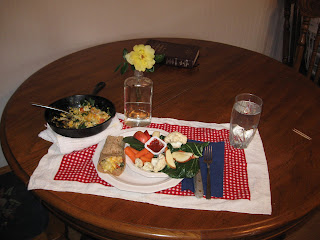"Life begins the day you plant a garden"
~~ Chinese Proverb
 |
| Egg, Cheese, and Kale Fajita |
Kale is SO Nutritious! And Simple to grow! I virtually threw seeds in the dirt and ignored it the whole summer, except when I cut leaves off to cook and eat. Below are some facts about Kale, and the advantages of eating it.
Until the end of the Middle Ages, kale was one of the most common green vegetables in all of Europe. Curly leafed varieties of cabbage already existed along with flat leafed varieties in Greece in the fourth century BC. These forms, which were referred to by the Romans as "Sabellian kale," are considered to be the ancestors of modern kales. Today one may differentiate between varieties according to the low, intermediate, or high length of the stem, with varying leaf types. The leaf colors range from light green through green, dark green and violet-green to violet-brown. Russian kale was introduced into Canada (and then into the U.S.) by Russian traders in the 19th century.
Kale freezes well and actually tastes sweeter and more flavourful after being exposed to a frost. Tender kale greens can provide an intense addition to salads, particularly when combined with other such strongly-flavored ingredients as dry-roasted peanuts, roasted almonds, red pepper flakes, or an Asian-style dressing.
A traditional Portuguese soup, "caldo verde," combines pureed potatoes, diced kale, olive oil, broth, and, generally, sliced cooked spicy sausage. Under the name of couve, kale is also popular in Brazil, in caldo verde, or as a vegetable dish, often cooked with carne seca (shredded dried beef). When chopped and stir-fried, couve accompanies Brazil's national dish, feijoada.
 |
| Plan to buy some Kale seeds and throw them in your dirt next spring. You'll be glad you did! |



No comments:
Post a Comment